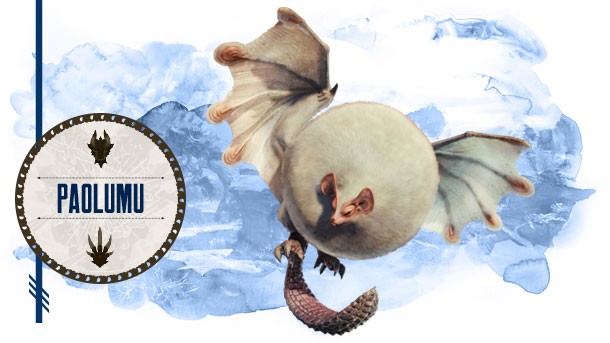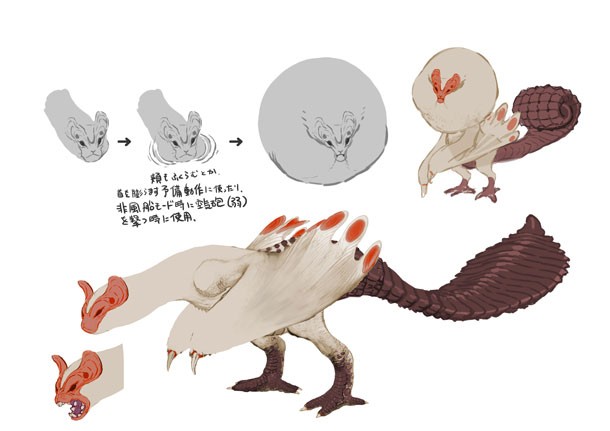Our extra-large special edition is here. Subscribe today and receive the 25% longer issue at no extra cost!
Monster Hunter: World Bestiary Day 1 – The Puffy Paolumu

Last week, we explored Monster Hunter: World’s Coral Highlands map, a striking location that looks like a dried-out version of an underwater paradise. This week, we’re taking a similar approach with three of the upcoming game’s monsters. During our visit to Capcom’s Osaka offices, we got exclusive presentations on the design process for each of these beasts, including a look at their early iterations and how they finally arrived at the versions you’ll be able to hunt in January.
Since we started with the Coral Highlands, it seemed only fitting that we kicked off this week’s coverage with a look at one of its most unusual inhabitants. The Paolumu may not be the map’s apex predator, but the creature is sure to leave a mark on those who encounter it – in more ways than one.
“The planner’s concept with this monster was that it would fit into the middle of the food chain somewhere,” says Kaname Fujioka, the game’s executive director and art director. “He’s not the toughest monster in the place, but he has some tricky aspects to him.” The Coral Highlands environment takes full advantage of Monster Hunter: World’s new tech, which allows its designers to build maps with more vertical elements than in previous entries. It’s only fitting, then, that the Paolumu also has been created with the map’s updrafts and other environmental features in mind.
“We thought that some kind of puffing up or inflating aspect would be quite interesting, because we hadn’t had a monster with an inflatable part before, and we took inspiration from creatures like squirrels and their pouches,” Fujioka says. “We thought this furry concept for a monster would be an interesting one to have, so after seeing all of these different designs coming through and working them out, we decided to follow up on this one with the furry inflatable pouch.”

Paolumu, like many creatures in the Monster Hunter universe, seems like a hybrid of many real-world creatures. In addition to the squirrel influence, you can probably call out a few other animals when you look at Paolumu. It has a batlike head, and its tail is similar to a beaver’s. The monster’s pouch makes him extra buoyant, so he can more easily ride the updrafts to navigate the Coral Highlands and also evade your attacks. The pouch has a defensive element to it as well. The Paolumu can forcibly expel that air in a windy blast that can knock unsuspecting attackers aside, too.
Blowing on enemies is a neat trick, but it’s hardly effective against the map’s prey. That’s where Paoluma’s tail comes into play, and it’s as versatile as its air pouch. It can attack in a couple of different ways, depending on how the tail is used. “One is to roll it up and use it as a very powerful pinpoint attack, and the other is to flex it out, and that’s a very wide-ranging attack,” Fujioka says. It’s basically the difference between a fist or an open-handed attack, and each offers its own strengths.
Monster Hunter’s artists and designers like to drill down onto the little details, and that includes the pattern that you see on Paolumu’s tail. “We came to the inspiration of the kind of texture you get on the end of a meat tenderizer mallet. We thought it would be something to cover his tail in, and then that becomes the texture that is part of his physiology as to why he’s able to attack you.”
Once the monster’s design is finalized, it’s time to come up with an official name. “Sometimes we’ll have a name right from the start, but that’s quite rare,” Fujioka says. “We’ll have an internal name, like the basic description of the monster, like ‘The bearded flying squirrel,’ this is a thing we’re making now. Then we’ll take its final concept and think, ‘How can we name it in a way that seems to make sense to us.’ What we usually do is take a variety of words from various languages around the world, and combine elements of them so that if you did dig deep into it, the monster’s name would have some meaning that would connect into it.”
Paolumu’s name is derived from two main sources, Fujioka says. The “Pao” part of it comes a Chinese word that has an association with buns and pouchy, baloony things. “Lumu” has French origins, with connotations of soft, wooly things. Put them together, and you have a name that offers additional insight into the creature – provided you know where to look.
“Once we complete the design for a monster, the next step is to design the armor that you can create from that monster,” Fujioka says. “The most obvious place to start seems to be the fur, since you’d be able to carve a fur part off this creature. What came to mind first were the queen’s guards from Buckingham Palace with their fur hats. That was almost too cool, and at that point we already had you getting a lot of quite-cool armors. Paolumu has a funny or amusing silhouette overall, so we thought we’d try to get that amusing aspect into the armor design.”
They admittedly went a little too far in that direction at first, with one scrapped concept making its wearer look something like a costumed actor at a Palico amusement park. They eventually landed on armor that retained the creature’s white fur and elements of its puffiness without going too off the rails.
Weapons follow a similar path, though function seems to be more of an emphasis. “We decide on a per-weapon basis how you hold it, which part of the monster you’d use,” Fujioka says. “If you were really creating a weapon out of parts, you’d put the softest or nicest to hold parts on the grip. For example, the grip on the gun has the fur, while the weapon parts or the powerful parts you’d use the dimpled texture of the tail, which is the powerful part. That’s how it applies on the hunting horn. The actual part where you’d hit the enemy has the tail section on it, but you grip the fur parts.”
Paolumu is definitely a weird creature, which was one of the things the team was trying to achieve. “We wanted this to show what makes Monster Hunter special and have it be something that you’d never seen before,” Fujioka says. Unless you know of any bat/beaver/squirrel monsters out there, they have succeeded on that front.
We have more Monster Hunter: World planned for the days and weeks to come, so be sure to visit our hub for more exclusive features, videos, and more.

Get the Game Informer Print Edition!
Explore your favorite games in premium print format, delivered to your door.
- 10 issues per year
- Only $4.80 per issue
- Full digital magazine archive access
- Since 1991










